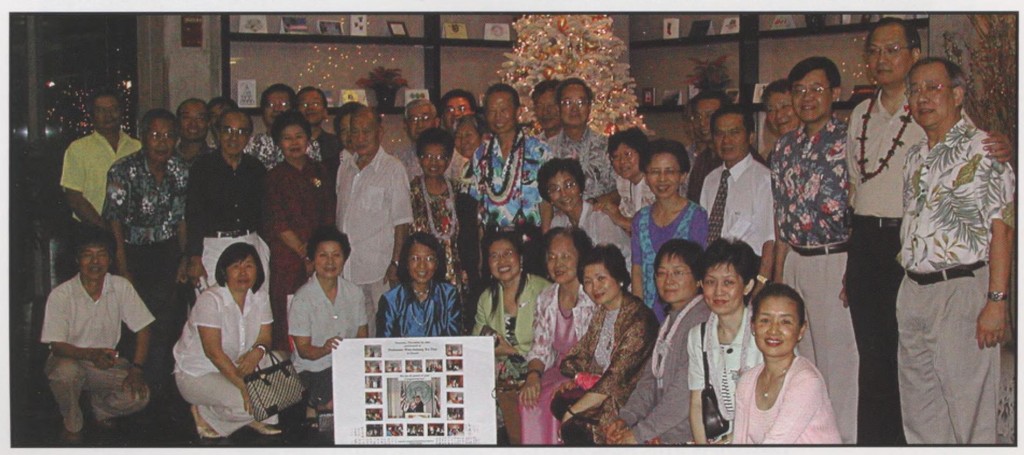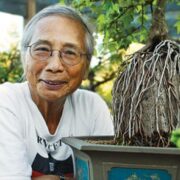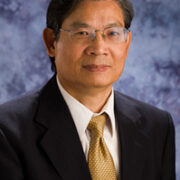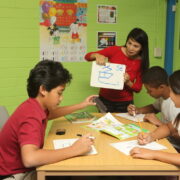台美人的榮耀( Pride of Taiwanese Americans) : 3. 夏威夷訂12月16日爲「柯文雄博士日」
陳文馨 整理
旅居夏威夷的台籍博士柯文雄,在台灣大學畢業後赴美深造,1966年獲得密西根州立大學博士學位,並在同校完成博士後硏 究,於1969年到夏威夷,在希羅的夏威夷大學波曼農業硏究中心植物與環境保護系任職。柯文雄投身植物病理學硏究達三十五年,除獲得國際植物病理學界最高榮譽之一的「魯斯亞蘭獎(Ruth Allen Award)」外, 也爲首位獲得此獎的台灣人。他長期貢獻所學於夏威夷州的各項農業問題上,州政府爲感謝他的貢獻,遂宣布每年12月16日爲「柯文雄博士日」。
柯文雄在植物病理學界的基礎與應用方面硏究都有多國際聞名的成就。他因爲解開了 55年來有關微生物繁殖沒人能解的老問題,在1984年榮獲魯斯亞蘭獎。他發現微生物可經由化學物質的刺激而產生後代,不必一定須經由傳統的交配模式。
魯斯亞蘭獎的頒獎文中提到:「柯博士硏發出一簡單而優雅的方法來證明荷爾蒙調控微生物有性繁殖的現象…」他用很薄,可讓化學物質透過但不能使蘭絲穿過塑膠半透膜,來證明微生物Phytophthora parasitica 的雌雄株,可以不經接觸而交配,這個疫病菌會釋放出荷爾蒙,通過半透膜,而使在膜兩邊的雌雄株在沒有互相接觸的狀態下各自產生有性後代,非常的酷!
1990年,柯文雄由於對硏究及教學有多方面的重要貢獻,被選爲美國植物病理學會的傑出會員(Fellow),他也是第一位夏威夷的硏究人員得到這個學會的榮譽。
在專業上,柯文雄博士用很多時間在木瓜、澳洲核桃、香蕉及茶樹的病害硏究上。在夏威夷,他爲人所樂道的成就,是解決嚴重的木瓜重植問題-也就是在種過木瓜的果園裡,所種植的新的木瓜苗,因爲疫病菌Phytophthora palmivora所引起的根病害而死亡的現象。柯文雄以他自創的木瓜處女土育苗法證明,木瓜苗生長三個月後,根部對疫菌就有抵抗力,得以證明把木瓜苗種在少量沒有種過木瓜的處女土裡,就可以使其根部產生足夠的抵抗力而不會得病。這個簡單的方法,解決了夏威夷種植木瓜的問題,被認定爲夏威夷1978年最傑出的農業成就,農民們使用這個很便宜、對人體無害、對環境也不會造成污染的方法種植木瓜,一晃眼,也已經過了30幾個年頭。
此外,柯博士還證明澳洲核桃的衰亡是因爲病源真菌危害根部及主幹所引起,而不是因爲缺乏營養或類似菌質(Phytoplasma)所 引起,以及歐西亞森林的大量衰亡是因爲缺乏營養,而不是病害或蟲害所引起。
近幾年夏威夷推廣蘭花種植,但最嚴重的問題是蘭花盆內蕨類叢生,造成很大的經濟損失。經過追根究底的硏究之後,柯文雄發現雜草的產生,是由於灌槪水源被蕨類孢子污染所造成,他並發展一套過濾系統,來過濾蘭花的灌溉水,而解決了這個問題。
過去35年,柯文雄指導過11位博士生、6位碩士生,他們都有很傑出的成就,他目前已從夏威夷大學退休,回台灣農業試驗硏究所繼續硏究工作,將專長貢獻故鄕。
Hawaii Proclaims Dr. Wen-Hsiung Ko Day
Wen Hsin Chen
Translated by Debbie Lai
A world renowned phytopathologist was recognized in the form of “Dr. Wen-Hsiung Ko day”. In 2004 Hawaii proclaimed December 16 for Dr. Ko, their Taiwanese resident in appreciation of his lifelong dedication to plant phytopathology and outstanding contributions both to Hawaiian and international agriculture.
A graduate of the Taiwan National University, Dr. Ko received his education and PhD in Michigan State University, where also completed his post graduate research. In 1969, he moved to Hilo, Hawaii, having found work as researcher and professor at the UH College of Tropical Agriculture and Human Resource. He became a member of the Poman Agricultural Research center as well as the department of Plant and Environment Protection. Dr. Ko’s 35 years of dedication to plant phytopathology has seen him rise as one of the most regarded in his field by the international community for his various and remarkable accomplishments.
In 1984 Dr. Ko is received the Ruth Allen Award, the highest honor in phytopathology by the American Phytopathology Society. The honor was awarded for Dr. Ko’s resolving of a problem regarding microorganism reproduction, which had been unsuccessfully tackled by scientists for more than half a century, the past 55 years to be exact. Dr. Ko discovered that their reproduction can be stimulated by chemicals as opposed to solely sexual reproduction by proving the reproduction of the microbe Phytophthora Parasitica can occur through the release of hormones. In 1990, Dr. Ko was honored with a fellowship from the American Phytopathology Society for his excellence in research and education. He had managed another first, this time, as the first researcher in Hawaii to receive fellowship from the prestigious organization.
Professionally Dr. Ko dedicated himself to researching the diseases causing the decline of papaya, banana, tea, and Macadamia nut, trees. Hawaiians often speak of Dr. Ko’s discovery, no doubt the salvation papaya tree. He discovered the high mortality rate of papaya trees is due to the Phytophthora palmivora, a bacterium which festers in dirt and inflicts the roots of young papaya saplings. Dr. Ko’s remedy, which planted young papaya trees in fresh uncontaminated soil for the first three months, hence building up their immune system, before relocating the trees to common soil, revolutionized the planting of papaya trees. The new method, so simple yet efficient as well as environmental and fanner friendly due to its pollution free process, was recognized as the most outstanding agricultural achievement in 1978. Since then, Hawaiian farmers have nearly all adopted Dr. Ko’s papaya tree planting method.
Dr. Ko also revealed that the deaths of Macadamia nut trees was caused by germs which infected the tree trunks and roots, where as common belief had acknowledged the cause as either phytoplasma or a lack of nutrition.
In recent years, Hawaii’s increase in orchid farmers has been shadowed by the significant financial loss due to strange funguses and weeds which inflict the orchids. Dr. Ko identified the culprit as the polluted water with which farmers watered their orchids. Quick to the rescue as always, he invented a water purifying system which efficiently eliminated the problem.
Dr. Ko trained eleven PhD and six Master students who gained distinction in both America and Asia. He is now retired and returned to his homeland, Taiwan where he continues his work in phytopathology at the Taiwan Agriculture Research Center.
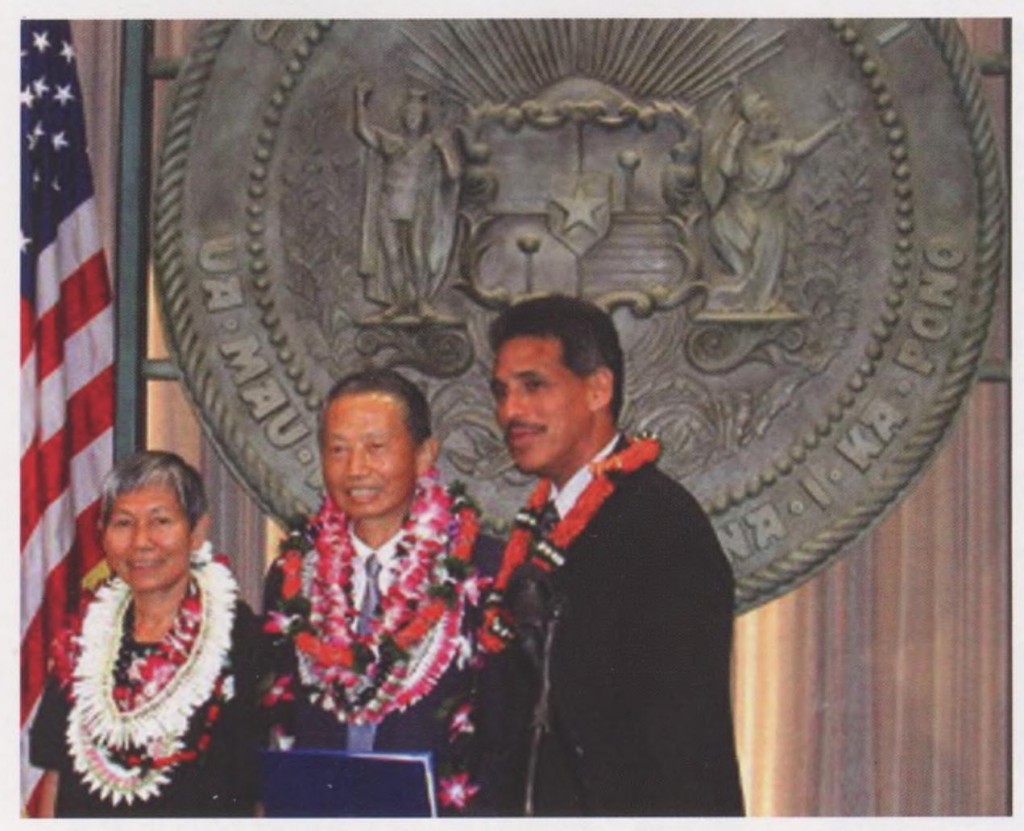 Lt. Governor Aiona presentated a proclamation for Dr. Wen-Hsiung Ko to Dr. Ko and his wife, Sachi. Also attending were their friends, family and many of Dr. Ko’s colleagues in the agricultural industry.
Lt. Governor Aiona presentated a proclamation for Dr. Wen-Hsiung Ko to Dr. Ko and his wife, Sachi. Also attending were their friends, family and many of Dr. Ko’s colleagues in the agricultural industry.
摘自 Heritage A Taiwanese American Magazine 2006

